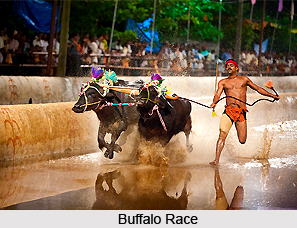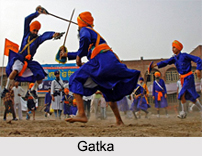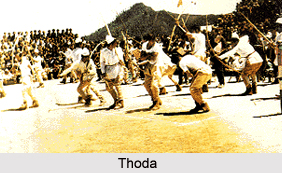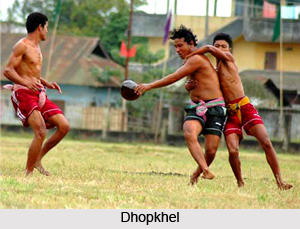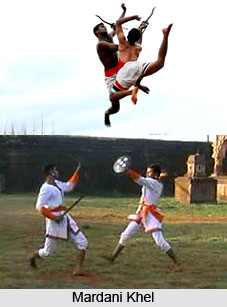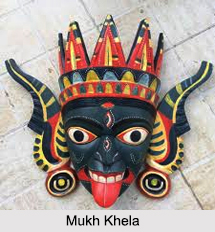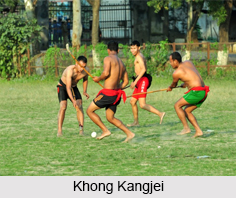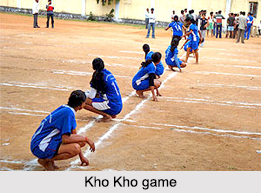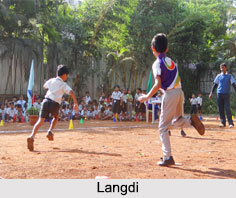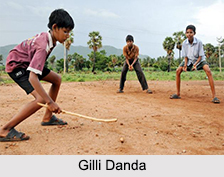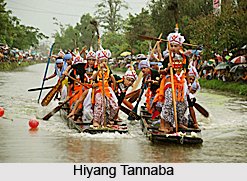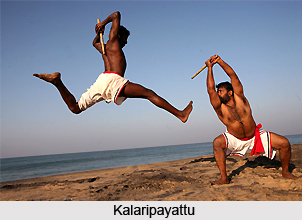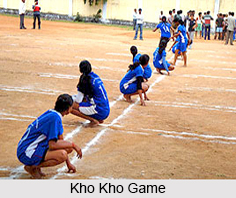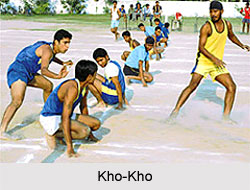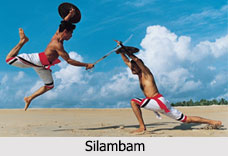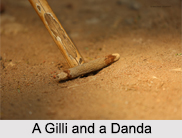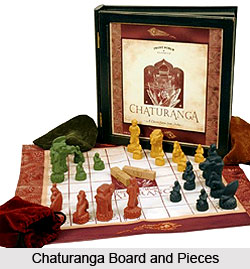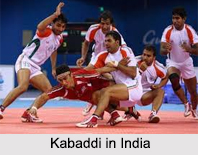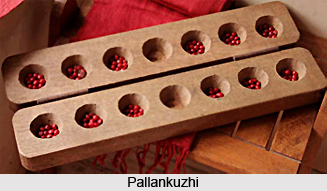Rural Sports in India bears the essence of various games and the assortment of sports played amidst the territory of India that mobilizes the rural sector at once.
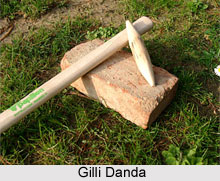 Gilli Danda is a popular village game played with two wooden sticks - a gilli and a danda. The gilli is about three inches long and tapered at the ends. The danda, about 2 feet long, is used to strike the gilli. The gilli is placed across a small oval-shaped hole in the centre of a small circle about four feet in diameter, is drawn on the ground. Two teams or two individuals as opponents against each other, play this game. However, Gilli Danda can be played individually too, without teams. Gilli danda is a popular village game of Indian soil which requires remarkable hand and eye coordination. Cricket or Baseball played with sticks instead of bats or balls, is exactly the structure of Gilli Danda. Gilli Danda is played with two wooden sticks - a gilli and a danda. Unlike modern games, any number of players or teams can play this game. That`s precisely the difference between the western and Indian games. One plays unconstrained, unleashed.
Gilli Danda is a popular village game played with two wooden sticks - a gilli and a danda. The gilli is about three inches long and tapered at the ends. The danda, about 2 feet long, is used to strike the gilli. The gilli is placed across a small oval-shaped hole in the centre of a small circle about four feet in diameter, is drawn on the ground. Two teams or two individuals as opponents against each other, play this game. However, Gilli Danda can be played individually too, without teams. Gilli danda is a popular village game of Indian soil which requires remarkable hand and eye coordination. Cricket or Baseball played with sticks instead of bats or balls, is exactly the structure of Gilli Danda. Gilli Danda is played with two wooden sticks - a gilli and a danda. Unlike modern games, any number of players or teams can play this game. That`s precisely the difference between the western and Indian games. One plays unconstrained, unleashed.
In this game, the striker tries to hit the gilli with the danda two times, once to lift it off the ground and then to hit it as far as possible. If he hits the gilli, the fielding team tries to catch the gilli before it touches the ground. If they succeed, the striker is out and the next player comes in to bat. If the fielders cannot catch the gilli, the distance between the central hole and the place where the gilli falls is measured with the danda. Each length of the danda counts for one score. After the score is recorded, the danda is placed over the central hole. The fielder, who was standing closest to the point where the gilli had fallen, tries to hit the danda with the gilli from where the gilli had fallen. If the gilli hits the danda or falls in the circle, the striker is out. If not, the striker gets another chance to hit the gilli. Each striker gets a maximum of three chances. The game continues till all the players have had their turn at striking. The team with the higher score wins.
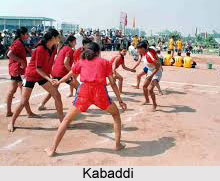 Kabaddi in India is counted among the most common and widely played traditional sports and a rural one for sure. There is a popular belief that Kabaddi originated in the Indian state of Tamil Nadu, almost 4,000 years ago. According to a legend, this game came into existence, when a boy hit another boy for his candy. The boy who was hit chased the boy who hit him, and hit him back and ran away. The feature of holding the breath while chasing, was added later when the game evolved. Kabaddi is the game, where one person play against seven people. Kabaddi is also known as the "Game of the Masses" and it has simple, easy to comprehend rules. The game requires minimum equipment while having all the ingredients of thrill and excitement and audience appeal. Sometimes, the people enjoy the game of Kabaddi more than any other popular game, like Football or Basketball.
Kabaddi in India is counted among the most common and widely played traditional sports and a rural one for sure. There is a popular belief that Kabaddi originated in the Indian state of Tamil Nadu, almost 4,000 years ago. According to a legend, this game came into existence, when a boy hit another boy for his candy. The boy who was hit chased the boy who hit him, and hit him back and ran away. The feature of holding the breath while chasing, was added later when the game evolved. Kabaddi is the game, where one person play against seven people. Kabaddi is also known as the "Game of the Masses" and it has simple, easy to comprehend rules. The game requires minimum equipment while having all the ingredients of thrill and excitement and audience appeal. Sometimes, the people enjoy the game of Kabaddi more than any other popular game, like Football or Basketball.
This is a team game that requires both skill and power on behalf of the players, and it also combines the characteristics of wrestling and rugby. In India, Kabaddi is quite famous and popular in the state of Punjab. There is also a popular belief that the game has its roots in the way Abhimanyu was killed in Chakravyuha by the Kauravas. Kabaddi is a rather simple and inexpensive game, and it does not require a massive playing area, or any expensive equipments. There are also some other ancient scripts that refers to the existence of Kabaddi in India. In Mahabharata, Arjuna had a unique talent in the game of Kabaddi, as he was able to go inside the wall of enemies, destroy them all and come back unscathed. According to the Buddhist literature, Gautam Buddha used to play Kabaddi for recreation. Apart from those manuscripts, history also reveals that princes of yore loved playing Kabaddi and took the game as a means to display their strength and won their brides. With due course of time, the game earned a lot of popularity in the Southern Part of Asia. For this inexpensive nature, the game of Kabaddi has become extremely popular in rural India.
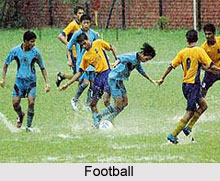 Kite flying is one of the most popular games in rural India. Kite is also known as `patang` in India and the thread that is used is known as `Manjha` a glass coated line and each flier remains in a perpetual attempt to cut out every other kite out of the sky. The kite flying festival is celebrated on the eve of `Makar Sankranti` in Jaipur as well as Gujarat state of India. In Bengal kite flying is popular during Viswakarma Pujas. Best in rest of India this game is struggling to save its long and historic existence.
Kite flying is one of the most popular games in rural India. Kite is also known as `patang` in India and the thread that is used is known as `Manjha` a glass coated line and each flier remains in a perpetual attempt to cut out every other kite out of the sky. The kite flying festival is celebrated on the eve of `Makar Sankranti` in Jaipur as well as Gujarat state of India. In Bengal kite flying is popular during Viswakarma Pujas. Best in rest of India this game is struggling to save its long and historic existence.
Kancha once a gully sport was popular of many young boys in town and villages nearby. It has its own modus operandi it being played with marbles called `Kancha`. The players are to hit the selected target `kancha` using their own marble ball. The winner takes all Kanchas of rest of the players.
Pitthu is also known to many by the name Satoliya, a simple rural and fun game where the players are divided into two teams. A small stack of flat stones and a ball are the two things required in this game. Each team takes their turns at toppling the stack and then they run while the other team has to hit/touch each of the players in the opposing team with the ball. If the team that takes their shot at the stack manage to rebuild the stack before they are hit/touched by the ball then they win. Any player who is hit is out of the game.
The Lattu or the spinning top is a popular game that is played in many parts of India even today. Lattu is a game that simply involves the spinning of a wooden lattu which has grooves in its lower half and a nail at the bottom to spin on. A cotton string is wrapped around the grooves on the lower half and deploying it makes it spin. Lattu is more than often a rural game and often played in a group.
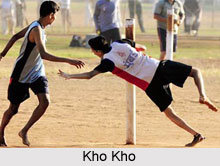 Kho-Kho is a popular tag game of 12 players where teams are required to chase down and tag the players of the opposite team to win this game. The chasing team have an array of nine players and they send them onto the field and they sit in a straight line with alternate players facing opposite sides, chasers have to make sure that they catch the runners before the stipulated time which is usually around 9 minutes per inning.
Kho-Kho is a popular tag game of 12 players where teams are required to chase down and tag the players of the opposite team to win this game. The chasing team have an array of nine players and they send them onto the field and they sit in a straight line with alternate players facing opposite sides, chasers have to make sure that they catch the runners before the stipulated time which is usually around 9 minutes per inning.
Indian football produced several legendary Football players so far, who have shown incredible performances on the Football field and mesmerised the whole world. The Indian Football players have earned significant recognition and reputation in the international circuit for their extraordinary skills. Some of the legendary Indian Football players include Gostha Pal, Subimal Chuni Goswami, Sailendra Nath Manna, P K Bannerjee, Baichung Bhutia, Peter Thangaraj, Sunil Chetri, Sangram Mukherjee, Alvito de Counha, etc. All these players have played extraordinarily on the Football field and also helped India winning many championships and bringing glory to the nation.
